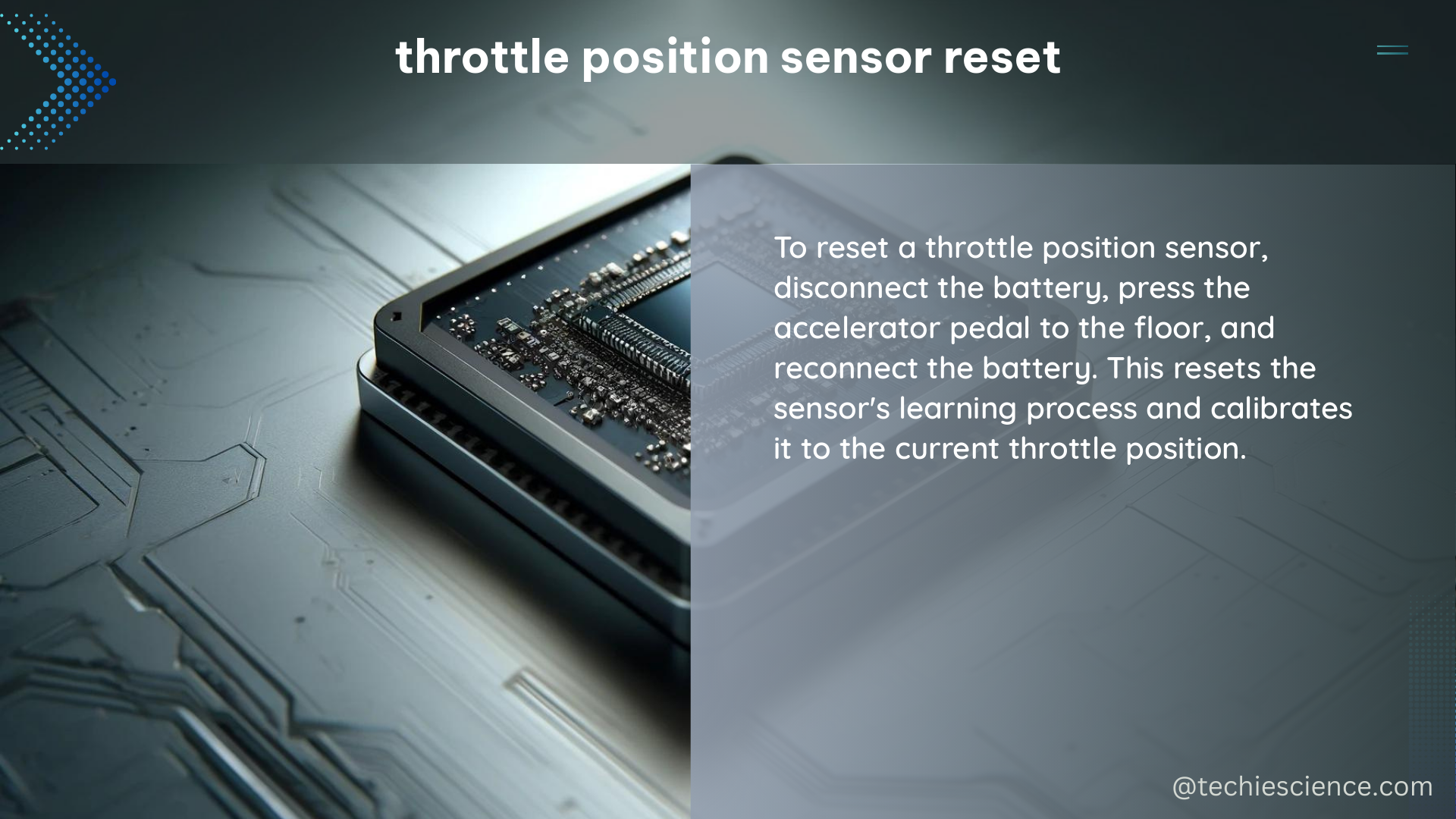A throttle position sensor (TPS) is a critical component in modern vehicles that measures the position of the throttle valve and relays this information to the engine control unit (ECU). Over time, the TPS can lose its calibration, leading to various issues such as poor throttle response, reduced engine performance, and even check engine lights. Resetting the TPS is essential to ensure optimal engine performance and fuel efficiency. This comprehensive guide will walk you through the technical specifications, common reset methods, and step-by-step instructions to help you reset your vehicle’s throttle position sensor.
Technical Specifications of Throttle Position Sensor
The throttle position sensor is an electronic device that typically consists of a variable resistor or a potentiometer. As the throttle valve position changes, the output voltage of the TPS also changes, which the ECU uses to adjust the fuel injection, ignition timing, and other engine parameters accordingly.
The TPS voltage range can vary depending on the vehicle make and model, but it generally falls within the 0.1 to 5 volts range. For example, in a 2004-2008 Ford 5.4L engine, the TPS voltage should be around 0.5 volts at idle and 4.5 to 5 volts at wide-open throttle (WOT).
The TPS is usually located on the throttle body or the throttle cable, and its precise location can be found in the vehicle’s service manual. It’s essential to consult the manual to ensure you’re accessing the correct sensor and following the manufacturer’s recommended reset procedures.
Common Throttle Position Sensor Reset Methods

There are two primary methods to reset the throttle position sensor: using a multimeter and using the vehicle’s diagnostic tool.
Using a Multimeter
- Disconnect the negative battery terminal: This step is crucial to prevent any electrical interference during the reset process.
- Locate the TPS: Refer to the service manual to identify the exact location of the TPS.
- Connect the multimeter: Connect the multimeter’s positive lead to the TPS signal wire and the negative lead to the ground wire.
- Start the engine and let it idle: Observe the TPS voltage reading, which should be around 0.5 volts for the 2004-2008 Ford 5.4L engine example.
- Slowly open the throttle valve: While monitoring the TPS voltage, gradually open the throttle valve. The voltage should increase linearly as the throttle valve opens, reaching 4.5 to 5 volts at wide-open throttle.
- Adjust the TPS: If the voltage readings do not match the manufacturer’s specifications, use the adjustment screw or the slotted mounting holes to adjust the TPS until the voltage readings are within the correct range.
Using the Vehicle’s Diagnostic Tool
- Disconnect the negative battery terminal: As with the multimeter method, this step is essential to prevent electrical interference.
- Connect the diagnostic tool: Plug the diagnostic tool into the vehicle’s OBD-II port, which is usually located under the dashboard or in the engine compartment.
- Access the TPS reset function: Navigate through the diagnostic tool’s menu to find the TPS reset or recalibration function.
- Follow the on-screen instructions: The diagnostic tool will guide you through the TPS reset process, which may involve specific steps such as opening the throttle valve to a certain position or following a specific sequence.
It’s important to note that the exact reset procedure may vary depending on the vehicle make, model, and year, so it’s crucial to consult the service manual or the diagnostic tool’s instructions to ensure you’re following the correct steps.
Additional Considerations
- Verify the TPS Voltage Range: After resetting the TPS, it’s essential to verify that the voltage readings match the manufacturer’s specifications. This can be done using a multimeter or by monitoring the TPS voltage through the diagnostic tool.
- Check for Diagnostic Trouble Codes: If the TPS reset does not resolve the issue, there may be other underlying problems. Use the diagnostic tool to check for any diagnostic trouble codes (DTCs) that may provide additional information about the problem.
- Replace the TPS if Necessary: If the TPS is damaged or worn out, it may need to be replaced. Consult the service manual for the proper replacement procedure and ensure that the new TPS is properly calibrated.
- Perform Regular Maintenance: Regular maintenance, such as cleaning the throttle body and checking the TPS, can help prevent future calibration issues and ensure optimal engine performance.
By following the steps outlined in this comprehensive guide, you can effectively reset your vehicle’s throttle position sensor and maintain optimal engine performance. Remember to always consult the service manual and use caution when working on your vehicle’s electrical systems.
References:
- How to Calibrate Throttle Position Sensor Using a Multimeter (Set & Test TPS) – YouTube
- How to Reset a Throttle Position Sensor – NAPA Blog
- Throttle Calibration vs PCM Reset vs ETC Relearn. does it really make any difference – LXForums
- tps wont relearn – EFILive Forum
- Throttle Position Sensor Reset? – Community of Ford Truck Fans

The lambdageeks.com Core SME Team is a group of experienced subject matter experts from diverse scientific and technical fields including Physics, Chemistry, Technology,Electronics & Electrical Engineering, Automotive, Mechanical Engineering. Our team collaborates to create high-quality, well-researched articles on a wide range of science and technology topics for the lambdageeks.com website.
All Our Senior SME are having more than 7 Years of experience in the respective fields . They are either Working Industry Professionals or assocaited With different Universities. Refer Our Authors Page to get to know About our Core SMEs.